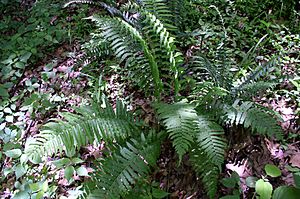Glade fern facts for kids
The Glade fern, also known as the narrow-leaved glade fern or narrow-leaved-spleenwort, is a type of fern found only in eastern North America. Its scientific name is Homalosorus pycnocarpos. This fern usually grows in damp, wooded areas. Scientists have changed its classification over time, but currently, it belongs to a small plant family called Diplaziopsidaceae. The other three species in this family are found in East Asia.
Quick facts for kids Glade fern |
|
|---|---|
 |
|
| Homalosorus pycnocarpos in mesophytic forest, Brown County State Park, Indiana, USA. | |
| Conservation status | |
| Scientific classification | |
| Genus: |
Homalosorus
|
| Species: |
pycnocarpos
|
| Synonyms | |
|
|
Contents
What the Glade Fern Looks Like
The Glade fern grows from stems that spread along the ground. Its leaves, called fronds, grow in clusters. These fronds can be up to about 90 centimeters (35 inches) long and 15 to 20 centimeters (6 to 8 inches) wide.
The main part of the leaf is shaped like a long oval. It has smaller leaf sections, called pinnae, arranged along it. These pinnae are long and thin. They can be mostly smooth or have small dents along their edges.
The fern has two types of fronds: sterile ones and fertile ones. The fertile fronds, which produce spores, look similar to the sterile ones. However, they are narrower and have more space between their pinnae.
On the underside of the fertile pinnae, you can find spore cases called sori. These sori are long, straight, or slightly curved. They grow in two lines. Each sorus is covered by a thick, noticeable flap called an indusium. The way these sori are arranged makes the fern's scientific name pycnocarpos, which means 'crowded fruits'.
How Scientists Classify the Glade Fern
Scientists classify plants to understand how they are related. The Glade fern's scientific name, Homalosorus pycnocarpos, has changed over time as scientists learn more.
The genus Homalosorus was first named by Rudolfo Pichi-Sermolli in 1977. Before that, the Glade fern was known by other names. For example, in 1803, André Michaux described it as Asplenium angustifolium. However, this name was already used for a different fern.
Later, in 1804, Kurt Sprengler described a species he called Asplenium pycnocarpon. Even though he wasn't sure if it was the same as Michaux's fern, scientists later agreed they were the same. So, Asplenium pycnocarpon became the first correct name for this fern.
Changes in Classification
The Glade fern has been placed in several different groups, or genera, by scientists.
- It was first put in the genus Asplenium.
- Later, it was moved to Athyrium.
- In 1977, it was placed in its own genus, Homalosorus.
- The Flora of North America once placed it in Diplazium, calling it Diplazium pycnocarpon. They noticed it looked similar to an East Asian fern called Diplazium flavoviride.
New studies using DNA (called molecular phylogenetics) have helped scientists understand how plants are truly related. These studies showed that Homalosorus and Diplaziopsis are closely related. Because of this, in 2011, scientists created a new family called Diplaziopsidaceae to include both Diplaziopsis and Homalosorus. This new family is now accepted by many plant classification systems.
Where the Glade Fern Lives
The Glade fern, Homalosorus pycnocarpos, is found only in eastern North America. It grows across a wide area, from southern Ontario in Canada down to the Gulf of Mexico. It also spreads west to Minnesota and Arkansas in the United States.
This fern likes to grow in moist woodlands and ravines. It prefers soils that are neutral or basic. You can find it at elevations ranging from about 150 to 1000 meters (500 to 3300 feet) above sea level.


